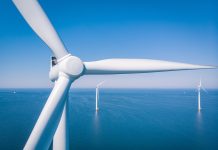American Chemical Technologies has offered its polyalkylene glycol-based lubricants to a variety of industries, and now the company is showing how it can help turbine gearboxes.
For more than four decades, American Chemical Technologies has supplied lubricants to a variety of industries. But over the last several years, the company has been making inroads in getting its special lubricants into wind turbines.

ACT is offering a lubricant unlike what has been traditionally used in turbines.
“Since the beginning of the wind industry, there have been issues with the lubricants,” said Steve Kovanda, product manager for ACT. “They have been — over 99 percent of the time — PAO-based fluids (PolyAlphaOlefin).”
ACT, however, offers polyalkylene glycol-based lubricants (PAGs), which have proven to have much longer life for machines in other industries, such as combustion and steam turbines, according to Kovanda.
“There’s only so much you can do to change a PAO,” he said. “You have your set spectrum of additives. They’re all using similar base stocks, so, at the end of the day, you can keep beating your head against the wall trying new PAOs, or you could go a different route and think, ‘these PAGs have worked fantastically in gas turbines, mobile equipment, air compressors, and other industrial gearboxes, so instead of trying another new PAO product, why not go for a different base stock and see how it works.’ That was the real driver for it. Because, at the end of day, a PAO is never going to be a fill-for-life fluid in a wind turbine, but PAGs have that capability.”
Getting into wind
ACT got that chance when an engineer with a leading energy company in Oklahoma decided to use a variant of ACT’s turbine fluid in its wind turbines.
“They ended up converting 63 units to our EcoGear 270 XP,” Kovanda said.
But he expressed how important it was to get a foothold in the wind industry with ACT’s PAG lubricant.

“The fact that we are uptower in 63 units in Oklahoma is a very big deal in itself,” Kovanda said. “Getting uptower is no easy feat at all. Turbines are expensive. To get up into 63 of those, you’re talking about people who are really putting their trust in you. I’ve been making a lot of progress with a lot of different corporations, looking to get some trials done, hopefully before the end of this year or early 2019. We’re also doing some work with NREL and Argonne National Laboratory. We are gathering data, which obviously takes time, but is necessary for us to gain a foothold in the industry.”
The big benefits of EcoGear and PAGs in general are that they are hydrolytically stable, and that they have excellent wear characteristics, according to Kovanda.
PAOs vs. PAGs
“Everything in the industry right now on these PAO fluids is that you want to keep it at 100 ppm of water or less,” he said. “With a PAG, you can handle 16,000 ppm of water without having any issues. That’s because that water in the fluid is not free water. PAGs have oxygen in the backbone of the molecule, and that acts as a bonding site for each of the water molecules. They can’t group together and form droplets. Once they form droplets, that’s where you have your rusting issues, increases in acid, foaming problems, etc. So, right off the bat, we totally crushed that in terms of eliminating that issue.”
Keeping moisture out of gearboxes is a constant challenge, so much so that some companies invest in dryers, according to Kovanda.

“They’re constantly blowing dry air across the top of the gearboxes in hopes of keeping the water out,” he said. “You don’t want that humidity in there. They are effective, but it’s just another piece of equipment you have to pay for. It’s another expense, and it’s another potential maintenance item. I’m sure those things will have their own issues as well.”
With PAGs, that extra expense is unnecessary, according to Kovanda. And chemically, PAGs don’t create sludge or varnish.
“It’s not as big of an issue in wind as in combustion turbines, for example, but I still have talked with engineers and site managers who have absolutely had issues where their gearboxes are just coated with varnish,” he said. “Another big benefit is that PAGs have a lower coefficient of friction and a higher load carrying capacity. Overall, they are just better lubricants. They can carry a higher load, and there is less friction created when the lubricant is used, meaning you will see a reduction in wear.”
Offshore possibilities
The ability to work when excess moisture is present is certainly an advantage that could lead to PAGs being used in the offshore wind market, according to Kovanda.
“Because the U.S. is far behind in offshore, we haven’t made much progress in offshore,” he said. “That is what my next goal is: to figure out who’s who in the offshore applications.”
Kovanda admits that PAGs can sometimes be a hard sell when PAOs are often the norm, but he said that’s just part of ACT’s overall philosophy.

“We’re always trying to think outside the box,” he said. “We’ve always taken the hard road. We are a formulator/blender. We can choose any base stock we want to make our own products. We could have easily formulated a PAO gear oil, gone to the industry, and just tried to push that. The end users — the OEMs — they’re all familiar with PAOs and would have been much more receptive to PAOs. But we know that PAGs bring you an entire other group of benefits. They can do so much more for these customers. So, we’d rather go with that uphill battle and truly try to help these industries out.”
ACT’s success with gas turbines is what has helped with the company’s expansion into the wind industry.
“We have now been in two GE 7FA units at two different power plants for over 10 years now,” Kovanda said. “And the units have been varnish free, trip free, for those 10 years. That is a very big deal. Before we got into the gas turbine industry, we were seeing that plants were getting anywhere from four to seven years of life before the units would be varnishing, tripping, and they would be losing out on hundreds of thousands of dollars because of these trips. For us to then come in and take that from four to seven years, now we are at 10 years, and the fluid is projected to run for another 25 years. With the life of a gas turbine being roughly 30 years, we should be a fill for life fluid in gas turbines.”
Gaining a foothold
Kovanda said he expects ACT to continue to impress the wind industry with its PAG lubricant.
“I definitely see us having a foothold in that market,” he said.

Eventually, ACT will have enough data from product tests to prove to other OEMs that its PAG lubricant is the better choice for longer gearbox life.
“Instead of going for trials, we’ll definitely have all the data that people want to see so they will be comfortable,” Kovanda said. “We’ll be converting full wind farms for certain users.”
Part of Kovanda’s mission with the wind industry is to convince OEMs of the benefits of his PAG lubricant, knowing full well that OEMs are a slow-moving group that will have to be convinced of the lubricant’s attributes, but he said he’s up for the task.
“Is it awful at times taking the hard road and going against everyone? Yes,” he said. “But do I also know that the products that we sell will outperform our competitors? Absolutely.”



























